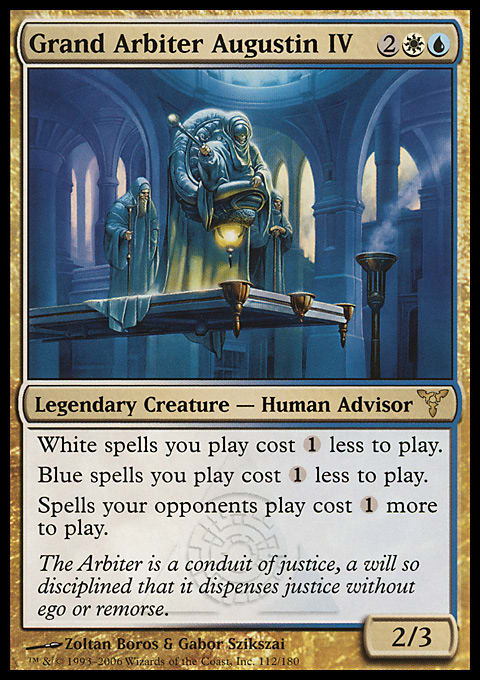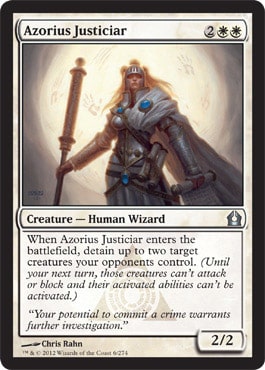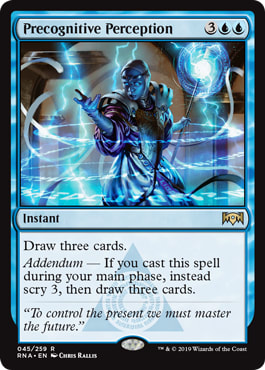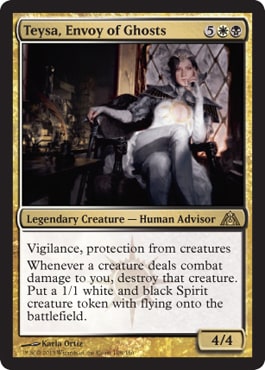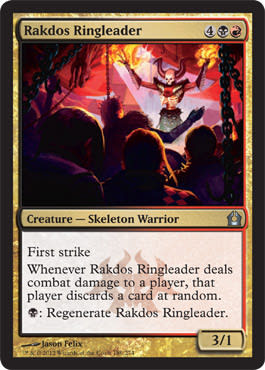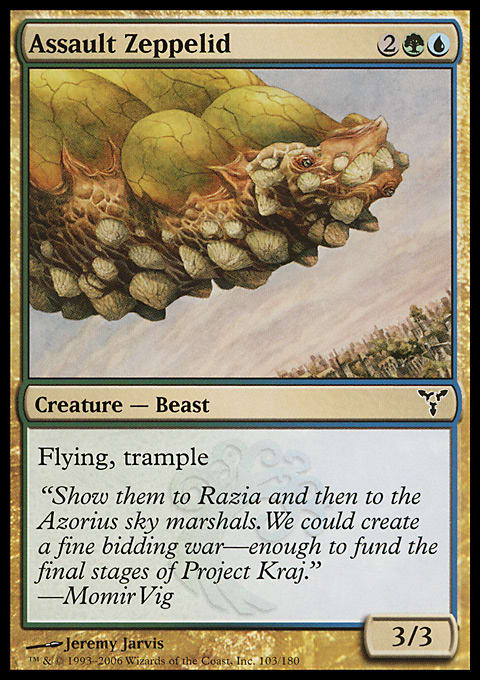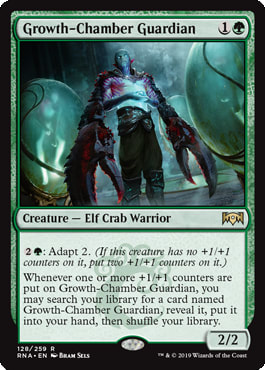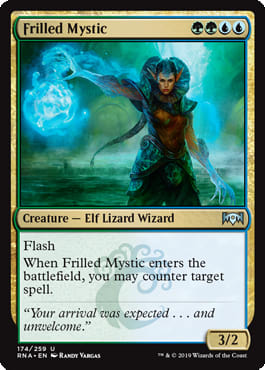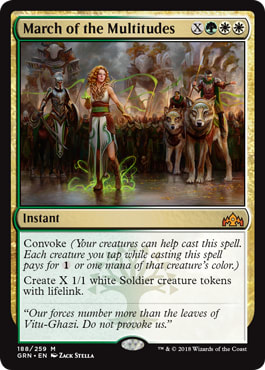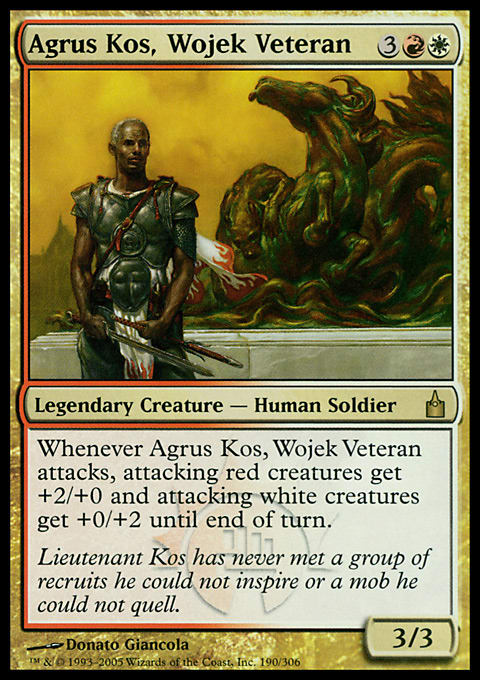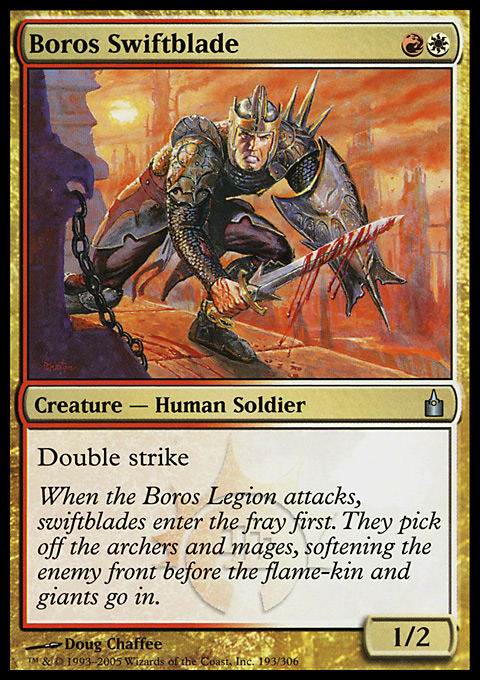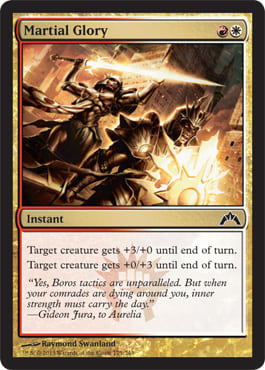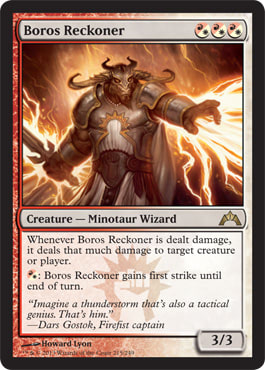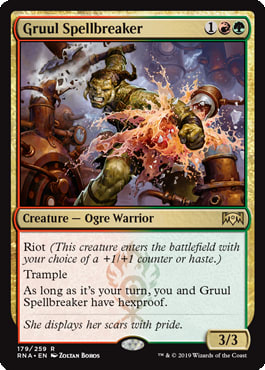Change is in the air, and with two sets of the newest Ravnica setting behind us we can see clearly how the marquee guilds of Magic: The Gathering's history have been redefined visually.
Like the historical three-set block structure, Ravnica Allegiance (RNA) is the second set of a three set "block", with the other two Ravnica blocks having only some guilds represented in each set. In RNA, we see the second half of the guilds, where players are to read flavor text and learn which guilds are Nicol Bolas (evil) influenced to set up the conflict in the third set.
This week, we saw War of the Spark, the set following this with a little previewed primer:
So, people are to wear their guild loyalty and conflict is coming. There are fewer direct conflict paintings with a Gruul member vs. an Orzhov member as of late, but most often this tension is represented with implied conflict. Also notable is a change not immediately apparent: the high amount of traditional paintings. Over forty paintings this go around, with folks like Matt Stewart getting six commissions!
To look at the guilds takes time and space. Having ten separate articles has its own set of logistical issues for future citations and scholarship. Instead, I chose to do a two-parter. In one, we discuss how guilds have changed visually, as told by known associates of the community. Next week, I'll review the set as a whole, considering the penultimate conflict that is to come, as any second set would do.
With that, each member of their respective guild is introduced and then explains how they see their own guild changing over time. They would know best, after all, on a visceral level. With that, let's dive in.
Azorius Senate
I asked Adrienne Reynolds, a woman of many hats and Azorius Senate member, what she thought of how Azorius has visually changed over time.
When we are asked, "which guild are you?" I say Azorius, but always with the disappointment that what I love is never in the story or the characterization of the guild even if it's sometimes present in the art. Mark Rosewater described the color pie identity in Azorius as blue seeking perfection and white seeking peace with:"The end result is the same. Both colors like to force its rules and ways upon all those around them". (1) This incredibly limited thinking about these colors as dystopian control rather than heroic undertakings of understanding or governing, show in the way characterizations have been drawn. We have no blue/white Mr. Smith's go to Washington in Ravnica's Azorius Senate, the work and Konnstructor architecture is only noted when it involves the prisons, and not any of the type of utopian building and creation of peace/function/ civic happiness that city planning actually strives to create in blue/white and real life. We don't get a Ruth Bader Ginsburg in the Sova Column.
But we look for them anyway - players who ID as Azorius and we found our hints of the positive in the art of the cards.
But there is a slight hint of the kind of joy that can be found in the law, and the sense that law can protect a multicultural population from oppressors rather than be oppressors themselves.

Skyscribing by Luca Zontini
In Ravnica Returns block, the use of the law as literal bond is shown with harsh lines but occasionally beautiful geometries and those of us looking for the harmony and joy of civic structures could find some hope even in tales of corruption and inaction.
Every debate team/student government Azorius identifying player-LOVED filibuster counters! The art showed individuals with faces not hiding behind giant artifices and the "light of the law" metaphor is delicate, skilled and careful. In law magic as a tool though is highly structured and strictly geometric:
 |  |
But the hopeful sign for us heading into Ravnica Allegiance is that instead of the focus on linear shapes - law magic now centers on the circle:
And finally we see a simple circle with a single body surrounded in truth - what blue and white would distill as their core goal:
It's a small thing for those outside the Azorius Senate but circles are about order with flow and connection, fluidity rather than rigidity. They are geometries that are at home while flying or grounded. And in the semiotics of Magic: The Gathering they show that we might be past the idea that law is an imposition rather than a negotiation with the population being governed.
There are bigger and fancier changes to Azorius imagery over time. But like all true legal policy activists - I watch how we write the law.
-Adrienne Reynolds
The final image, and the only image of Azorius that explains the set is that Dovin Baan is working for Nicol Bolas, the elder dragon planeswalker big bad guy, and has declared martial law to get there. We can see the seed planted in Return to Ravnica that this guild was planned on proactively doing something negative to Ravnica.
They are the Minority Report of "future crime" and as such, they can be the guild Nicol Bolas can twist to stop insurgency from happening, complete with drones, false admission circles and the ability to detain, forecast, arrest and add addendums to their laws in an instant, with even more gravitas if they plan it well during a main phase.

Deploy by Sara Winters
Digital
Bolas and Dovin Baan only forgot one part, sphinxes don't obey masters. This card was even highlighted in the addendum official rules video to make sure players saw the mechanic on a storyline quirk of a card.

This visual storytelling is woven quite well to see a guild twisted in on itself, with a thread going back to their roots on how a strength will be everyone's downfall. In addition to the sphinx, a full guild is on their opposite end: House Dimir. To combat Nicol Bolas's influence, House Dimir found a solution: to forget.
House Dimir
I went to Chase, known faerie collector, to ask her about her guild, House Dimir.
"When I look at Dimir from original Ravnica, they seem very grunge. They are very underground and in the shadows and sewers. The aesthetic of the art even has an appearance that there's kind of a layer of grime over the Dimir.
 |  |
They were assassins and didn't present as much else. Looking at them now, they're still in the shadows, but they're out on the streets. They look cleaner, nicer, and wealthier!
 |
 |
They have better clothes and better weapons! They're stealing and erasing memories, spreading rumors and lies, and their technology seems more advanced especially in the beautiful blue links of Mission Briefing and Never Happened).
 |  |
The Dimir seemed to have evolved from underground hired hands into something much more powerful and terrifying."
-Chase
They definitely have. They are the information brokers, the archivists and those who know things. It's better to simply ignore them and not meddle. House Dimir knows you. And they are not ones to be trifled with. They're aware of a greater scheme and they're now activated.
They are now acting on what they know and protecting their own from sharing, whether willingly or involuntary. By removing their own memories, a self-mill, they lose the secret they had that Azorius is looking for. David Palumbo shows this perfectly, as if this human is being detained and in the moment, forgets everything, to save it all.
Normally, this instability would be of massive profitability to House Dimir, but it's too much, too quick. It's unstable and with Azorius bearing down and Orzhov quite literally killing their patriarchy, House Dimir is on their own high alert. Anarchy is not good for business.
Orzhov Syndicate
You can haunt.
You can extort people, for a while.
But when push comes to shove, the guillotines or a planeswalker that is having none of the business as usual will arrive.
In hearing of the mafia church guild, its life and death, and ways its taxes have a very subtle progression, it must be highlighted. I asked Michelle, a life-indebted soul to the Orzhov, her perspective on how her guild has changed:
In terms of costume, the Orzhov have changed the most when you look to the women of the Syndicate. In original Ravnica block, their clothes were form fitting and featured the iconic sun shaped "boob window," highlighting the character's cleavage in a clear appeal to the male gaze.

Angel of Despair by Todd Lockwood
While in Gatecrash, the bosom aperture continues to infiltrate their apparel, the women begin to become portrayed more as person's of authority. In the case of Cartel Aristocrat, the boob window disappears altogether.
By the time we reach Allegiance, the boob window has disappeared entirely in favor of practical armor and regal robes. This is most well seen in Teysa's evolution over time, but her flowing dress and gold accents are reminiscent of a judge's robe or a priest's cassock. A much more refined and regal look for this Orzhov leader.
-Michelle
Michelle's absolutely correct as we see the power dynamics shift, look at the stance, the swagger to the role Teysa now holds. She went from a scion to an envoy, to it being simply her name now with flavor text.
There has not been a more literal dismantle the patriarchy moment like Kaya literally killing the ghosts of the guild's past, eliminating the sins of the fathers.
The women of Orzhov are exuding power like never before, as the "afterlife" mechanic has removed the previous and a new power, like Yongjae Choi is showing with Pitiless Pontiff. It's the same guild, the same power structures and wealth, just the management is headed in a different direction. Their future is female.
I definitely note the brighter, religious tone compared to mafia simply by using more light. I love the pointed arches of their guildgate cathedral, complete with realistic flying buttresses. I wrote about those in years past, if you're unaware of the concept. Their upheaval and brighter future counters to the Cult of Rakdos, who other than a few run-ins with the law per usual-visually, they're still...happy.
Cult of Rakdos
Hearing from April King, one of my local known associates, she is succinct on how Rakdos has changed:
Prior to Ravnica Allegiance, the Cult of Rakdos was perhaps the guild most poorly represented on Magic card art. Although they formed the backbone of Ravnica's pink-collar and entertainment industries, most Magic players could never relate to the spike and blood-covered fetishists historically depicted.
That changed with Ravnica Alliance, where the Magic card art finally captured the hedonistic desire for FUN that the Rakdos are truly about.
-April

Concept art by Tyler Jacobson
Speaking with Ant Tessitore, another Rakdos member, he mentioned how Rakdos was unapproachable originally on purpose. Their events were in their pits, unseen and unknown, and weren't seen unless they had nothing to do, becoming hellbent. The change in Return to Ravnica block was the unleash mechanic, targeted at non Rakdos members who were allowed to see the shows and become "unleashed" with the entertainers. For Ravnica Allegiance, Rakdos is now performing on the street. They are an accepted spectacle because so many members of Ravnica have seen their shows, or had them plan a party for their boring blue-based guilds or guildless event.
If you think Rakdos is in the spotlight more, the Izzet League is in public and absolutely shouldn't be with experiments.
Izzet League
There are countless Izzet members in the Magic community, so instead of going back to the well, I found the logical choice for where we all find inspiration. I asked Seth, more commonly known as SaffronOlive, what he thought of his guild:
While Izzet has always been weird (quite literally), across the three Ravnica blocks we see the guild slowly transform from scientist to mad scientist. Back in Guildpact Izzet's inventions are sleek, sharp, almost Kaladeshian machines like Mizzium Transreliquat by John Avon.

Mizzium Transreliquat by John Avon
Throughout the set we see the energy that goes into making such inventions in cards like Invoke the Firemind and Mimeofacture, although it typical appears as if the guild has harnessed it's powers.
 |  |
In Return to Ravnica, the experiments become more epic and also more volatile. You can also see Ral Zarek's influence.
 |  |
While the we see the same energy carry over from the original Ravnica block with cards like Electrickery, Nivmagus Elemental and Izzet Staticaster, there are signs that the guild is slipping a bit.
This leads us to Guilds of Ravnica. In the third Ravnica block, we still see wise leaders in Ral and Niv-Mizzet as powerful and controlled, but beneath the surface it becomes fair to wonder if the guild is still in control of their creative, experimental powers. We're more likely to see an Explosion, a frantically rough looking Experimental Frenzy or a Runaway Steam-Kin that we are the crisp Kaladesh-like inventions of the original Ravnica block.

Experimental Frenzy by Simon Dominic, Digital
While Izzet still has its power, these powers more likely to lead to an Inescapable Blaze of a disaster than a controlled Leap of Flame. Perhaps nowhere is this evolution more evident that in Steam Vents itself, which transforms from close-ups showing off its clean steam power in Ravnica and Return to Ravnica to a huge, asymmetrical mad scientist tower with unruly bolts of energy in Guilds of Ravnica.

While Izzet is still inventing as they always have, at this point we have to wonder whether the guild has lost itself in its power and perhaps become the victim of its own experimental genius.
-Seth, more commonly known as SaffronOlive
From Project Lightning Bug, Ral Zarek's enchantment to detect planeswalking by Niv Mizzet, to hearing of Ral's background with the misunderstood guild, it has a major role with Nicol Bolas's storyline. It's not like this project is connecting....
Simic Combine
Yes, it is so bad that Simic is just building armor.
We have oodles of Simic member in our ranks. They are fully aware of the impending conflict. They have been building adaptations for an all-out guild war, compared to their past, where the #1 Crab/Frog/Wizard fan Loreley can explain in depth:
The visual style of the Simic Combine is closely tied to their role in Magic's story. The original incarnation of the guild was defined by cytoplasts, magical bubbles of genetic material that augmented organisms.
They can be seen on most creatures in the guild. But at the end of the Dissension story, the entire guild died.
A new Simic Combine arose in Return to Ravnica, abandoning the cytoplasts and embracing the krasis, an organism of mashed-together animal parts.
Ravnica Allegiance fully embraces a lab coat aesthetic and adds mutant humanoid supersoldiers to the guild's visual identity.
-Loreley Weisel
Simic's changes aren't fully realized in the flavor text to impact the narrative of the storyline. This is a great counterbalance to the guild that does, which I'll get to in the Gruul. Their heavy usage of mechanical text omits their ability to inform us deeper. Instead, we are forced to look at them visually to see what they actually know, because like the Dimir, they're aware of a great plot and are reinforcing themselves for it. (Read the flavor text below.)
Selesnya Conclave
I love asking cosplayers about the changing of garb from concept pushes. They are the ones who physically must recreate them, often making them experts in nuance created or shifted. I asked my favorite Selesnya member Erin Adams to elaborate on her guild pride.
My favourite thing about the Selesnya aesthetic is the way everything exists together, like the buildings are part of the trees just as the trees are part of the buildings. Even though details have changed over the years, the essence of harmony with nature hasn't changed.
-Erin
Selesnya was the main tie for the change to Ravnica in autumn. They are the trees, so making them living embodiments for change was a seamless one. I spoke about it in my last art review for Guilds of Ravnica. The big change is they were the accepting guild, if you agree with them, and now are entirely prepared for war. They are akin to Simic, except their numbers could be prepped faster.
They also now, at least through Emmara Tandris, their guild champion, of some manner of information about the greater outside threat. They may not know about Nicol Bolas, but in an act of preservation, their flowing robes are now armored.

Vicious Rumors by David Palumbo
They see conflict, and they also see renewal, though unlike the Gruul they have a protective role in it. The flavor text to the below masterpiece by Howard Lyon shows their role of reluctant inevitability, that being their dryad Mat'Selesnya the dryad. Quite literally a tree leads the guild, and now, a giant acorn is being shown. Perhaps they already know they are going to lose, or maybe they just have a renewal plan, just in case.
"I hold the seed of our new beginning."
The Boros Legion
Of the ten guilds, the philosophy and visual iconographic elements of the Boros have changed the least. From Tomas Giorello's first iterations of what a Wojek soldier and a fiery angel, later to be Razia or Feather, have been consistent in the style guides. While squat, stout buildings to reinforce strength were clarified in Return to Ravnica, the Battalion to Mentor mechanic are similarly shown-more soldiers. But that's not the whole story. I asked two Boros Legion members what they thought on their guild, and Jamie Keller had this to say:
To me, the art for Boros through the sets shifted alongside the themes of the sets themselves. This sort of makes sense since the Boros would consider themselves the city's lifeblood and immune system, partially defining the state of the city, fully enforcing and embodying the current status quo, and while the city thriving to ailing doesn't cause similar changes in the Boros, either change is likely caused by the success of failures of the Boros.
In the original Ravnica block, there was an emphasis on action, on movement, and on sharp lines and details. Some of this might just be overall artist selection and art direction, but I like to think it was intentional. It was Spring in ravnica, and the Boros has never been more sure of themselves. Each Boros was secure in their personal righteousness and had never seen anything to prove them wrong. The soldiers, the trumpeters, the goblins and the angels, each emphasized in the art through hard lines (some fine and some thicker) and through glorification of their role and glory.
In the Return to Ravnica block, the perceived perfection of the status quo had been thrown aside. As the force of conformity, the Boros would have felt this strongly. And yet it was summer in Ravnica, and they clung to each other, now that they couldn't inherently trust the perfection of the guildpact and their traditional role. In the art, militarization and especially teamwork is emphasized. The sharp lines are less present, and the colors of white and red seem more often to blurb together into a warm glow. Action is present, but it often seems to focus on the moments between action, the marching formations, the forms of battle.
In the newest set, it is a darker time for Ravnica, and autumn has touch the Boros as well. For a guild based on order and unity and conformity inside and out, on trusting the system and enforcing the norms....seeing fractures in society hits a Boros soldier hard, but seeing fractures within the Boros shakes them to the core. The art is focused more on individuals again, and with a MUCH heavier emphasis on darker colors, on shadows, and further on moments between action. I see increased concern and contemplation and second thoughts, where before there was only righteous fury.
Let that sink in.
To explain even more, let's check in with Adam Styborski, ie Stybs, fresh off his Commander new role, what he thought:
I don't feel like it's changed all that much, but the tone of how it feels has subtly shifted. The old art sketches of boros from the OG Ravnica set captured that I fell in love with Boros: Strength conveyed through appearance. Not violence, Not spectacle. The kind of strength that someone who knows what they're doing, and what they're looking for, conveys just by how they look.

There used to be more that felt defensive, protective. Cards like Boros Recruit, Boros Guildmage and Agrus Kos look ready to act, not already engaged in fighting.
There were always aggressive-feeling cards but what was more "protector of people" is now "army attacking everyone."
Legion Warboss leading a charge. Skyknight Legionnaire, printed each time, was originally shown an inspirational in a military parade but now leads a host of Skyjeks in an attack.
 |  |
Sunhome Stalwart isn't standing guard, impassive like the old Sunhome Enforcer, but readying what could be a killing blow. Wojek Bodyguard? Protecting his captain with a sword drawn at the ready, not the people of Ravnica. The calm readiness of Agrus Kos is now totally fervent ferocity--organized, but ferocity nonetheless.
-Stybs
The least changed guild takes us to the largest visual change, the Golgari.
The Golgari Swarm
They are the recyclers, trash disposal, and food supplier to the city. The Golgari are also difficult to visually describe, as they live underground and have zombies, but their saprolings, a plant-based humanoid, differs from other planes. Showing rot, death and decay is often grotesque, which necessitated a new direction for them. I asked known Golgari commander general builder and noted ![]()
![]() enthusiast Bennie Smith for his thoughts on his favorite guild:
enthusiast Bennie Smith for his thoughts on his favorite guild:
When I look at the art on gold Golgari cards, there's a feeling between Ravnica: City of Guilds, Return to Ravnica, and finally Guilds of Ravnica that the Swarm is increasingly operating under the ground. In the first Ravnica set, much of the art was lighter shades, and the backgrounds seems to suggest that Golgari has a definite presence above ground but in the more shadowy places.

Golgari Guldmage by Zoltan Boros & Gabor Szikszai
Looking at the newest cards, it seems darker and you get the sense most of the Swarm's action is subterranean these days.
 |  |
What might be going on far from prying eyes?"
-Bennie Smith
They, like the Dimir, gained a high fashion flair. Gaining popular reference like Project Runway, the Golgari added organic material to their clothing. The elves now wear mushroom dresses, with the males having shoulder (pads?) accentuated to dramatic effect. The difference from Dimir, though, is the wish to be seen, vs. simply being out of the shadows as both were. Golgari now wants to raise their profile of being more than underdwellers. They have been busy, seeing Ravnica's inevitable future, and are gaining prominence and relevance in doing so. Add in the enigmatic Vraska, and their intrigue is back, with a flair for the dramatic.
Gruul Clans
The microcosm of Ravnica can be summed up by the most misunderstand guild.
Asking Gruul member John Dale Beety, former freelance flavor text writer for Wizards and Vorthos columnist what he thought on the visual evolution:

In their original appearance in Guildpact, the Gruul Clans were perhaps the biggest misfire of all the guilds. They didn't have much elaboration beyond "wild misfits of a city-plane," and their guild symbol was much too fancy as seen on the original Gruul Signet by Tim Hildebrandt.
One thing Guildpact did get right was picking artists who could convey a sense of the primal, such as Paolo Parente with his thick outlines on Ghor-Clan Bloodscale.

In Gatecrash, the Gruul got more thoughtful treatment, showing new sides of Gruul as on Predator's Rapport by Matt Stewart, and the guild symbol became simpler and more effective, as seen on Gruul Charm by Zoltan Boros.
 |
 |
Ravnica Allegiance uses the same trick of the "artist of the primal," most obviously this time with Zoltan Boros, who was, with Gabor Szikszai, responsible for the basic lands of the primal shard of Naya in Shards of Alara.
-John Dale
He is utterly right. The guild without a clear visual direction reflects the guild itself-directionless, until now. They now have a visual narrative, a purpose, and they are mad as heck.
All their training now has reasons for why it was done:

They have a prophecy and its time is now.
They went from practice into action, fighting back against the Azorius who are imprisoning them without due process. The former forest rangers, explained on Sunder Shaman are finally fed up with being mistreated. And, they have a reason for doing so - their prophecy of their old god is to return.
From the scrying oracles in Rubble Reading, to the prophecy of the Raze-Boar god returning, Gruul are not worried about what Izzet is doing, nor are they surprised by Azorius.

The warring band now has purpose both within Ravnica and visually.
"Your precious laws can't save you now!"
With War of the Spark now announced, two major references to previous deities mentioned, the guilds prepare for their next chapters at best. At worst, they fail to see the machinations at work, and guilds become irrelevant, reformed from a Boar god. All the past allusions are begging to be sought out, like seeing the darkened figures in the back of paintings.
The visual story of progression is not a linear one, with red herrings mixed in with actual storyline significant plants like our priest here below.
One thing is for certain though, will the Magic team be able to reshuffle the guilds, and easily return to the well plane for when a boost to Magic is needed? Can they afford to not have all ten guilds in the future? Are these old gods a plant for a Theros block in the near future, keeping gods in the standard format and resolving Elspeth's story of being sent to their plane's underworld?
-Mike















